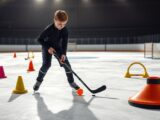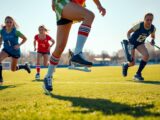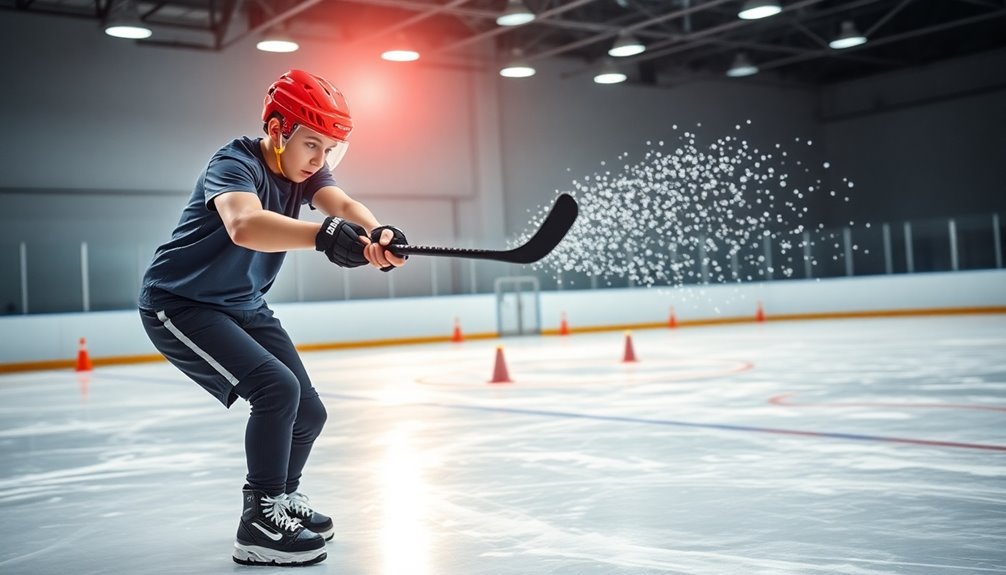
Boost Your Reaction Time With These Hockey Exercises
December 30, 2024To boost your reaction time in hockey, focus on exercises that enhance agility, coordination, and cognitive processing. Try the Ball Drop and Sprint Exercise to improve spatial awareness or the Partner Mirror Run Drill for agility and responsiveness. Incorporating the Shuffle Catches Technique simulates game scenarios, sharpening your reaction speed. Additionally, tools like the Hockey Reaction Ball and training programs like the 30-Day Breakaway Speed System can offer structured routines for continuous improvement. By committing to these drills, you'll gain a competitive edge on the ice. Discover even more effective strategies to elevate your game further.
Understanding Reaction Time
Understanding reaction time is fundamental for any hockey player looking to enhance their performance on the ice. Reaction time measures the interval between when a stimulus is presented and when you initiate a response. This skill is essential for making split-second decisions during gameplay. Fast reaction times allow you to anticipate opponents' moves and respond effectively, giving you a competitive edge.
Your cognitive skills play an important role in reaction time. Perception, anticipation, and the ability to respond to visual cues are all interconnected processes that help you execute precise movements. Additionally, practicing drills designed to improve anaerobic capacity can further enhance your reaction time. Cardiovascular endurance is also crucial for maintaining performance levels throughout the game.
Several factors influence your reaction time, including genetics, training experience, physical fitness, and mental focus. Environmental conditions, such as ice quality and lighting, can also impact your performance. Additionally, incorporating core strength exercises into your training can significantly improve your stability and overall athletic performance.
The good news? Research shows that reaction time is trainable. With consistent practice, you can see measurable improvements in your athletic performance.
Importance of Quick Reactions
Quick reactions are essential for enhancing your game performance in hockey, allowing you to anticipate plays and make split-second decisions.
When you improve your reaction time, you gain a competitive advantage over your opponents, making you a more effective player. Incorporating high-intensity interval training can significantly enhance your reaction time and overall performance. Additionally, plyometric movements can also help in developing explosive power that contributes to faster reactions on the ice.
Focusing on quick responses can be key to mastering the dynamic nature of the game. Additionally, incorporating quality training sessions can significantly enhance your reaction time and overall performance.
Enhancing Game Performance
In hockey, reaction time can be the difference between victory and defeat. Quick reactions allow you to anticipate your opponents' moves, which is vital for better positioning on the ice. When you improve reaction time, you can make split-second decisions that lead to effective plays and scoring opportunities.
By focusing on reaction time drills in your training, you can enhance your agility, helping you navigate rapidly changing game scenarios. Research shows that athletes with superior reaction times are more successful in intercepting passes and responding to opponents, directly impacting the outcome of games.
Consistent training aimed at improving reaction time not only sharpens your skills but also boosts your confidence during matches. Incorporating specific drills into your regular practice routine guarantees you're prepared for whatever comes your way.
Ultimately, enhancing your reaction capabilities can make a significant difference in your overall game performance. So, commit to these drills, stay focused, and see how your improved reaction time can elevate your play on the ice.
You'll find that quicker reactions translate into greater success during critical moments of the game.
Competitive Advantage Gained
Gaining a competitive edge in hockey hinges on your ability to react swiftly to ever-changing game dynamics. Quick reaction times let you anticipate your opponents' moves, enabling you to make split-second decisions that can lead to scoring opportunities or essential defensive plays.
When you possess faster reactions, you can exploit openings in the defense more effectively, boosting your chances of executing successful plays and scoring goals.
Research shows that players with elite reaction times of 0.2 seconds or less often outperform their peers, which can determine the outcome of tightly contested matches.
In high-pressure situations, those superior reaction abilities help you maintain focus, demonstrating greater mental resilience. This means you're better equipped to make smart decisions under stress.
Key to Anticipation
Anticipating plays in hockey hinges on your ability to react swiftly to the unfolding action on the ice. Quick reactions are essential for effective anticipation, allowing you to read the game and make split-second decisions that can change the outcome of plays. When you improve your reaction time, you can exploit defensive gaps and create scoring opportunities more efficiently than slower players.
Cognitive processing plays a crucial role in enhancing your reaction time. By training yourself to perceive visual cues and anticipate opponents' movements, you can greatly enhance your performance on the ice. Remember, reaction time isn't just about physical speed; it's about how quickly you can interpret what's happening around you.
The good news? Reaction time is trainable. Consistent practice with specific drills can lead to noticeable improvements, helping you adapt to the fast-paced nature of the game.
As your reaction capabilities increase, you'll not only boost your individual performance but also contribute to better teamwork and communication during high-stakes situations. Focus on honing your anticipation skills, and you'll find yourself making smarter plays and impacting the game in a positive way.
Factors Influencing Reaction Time
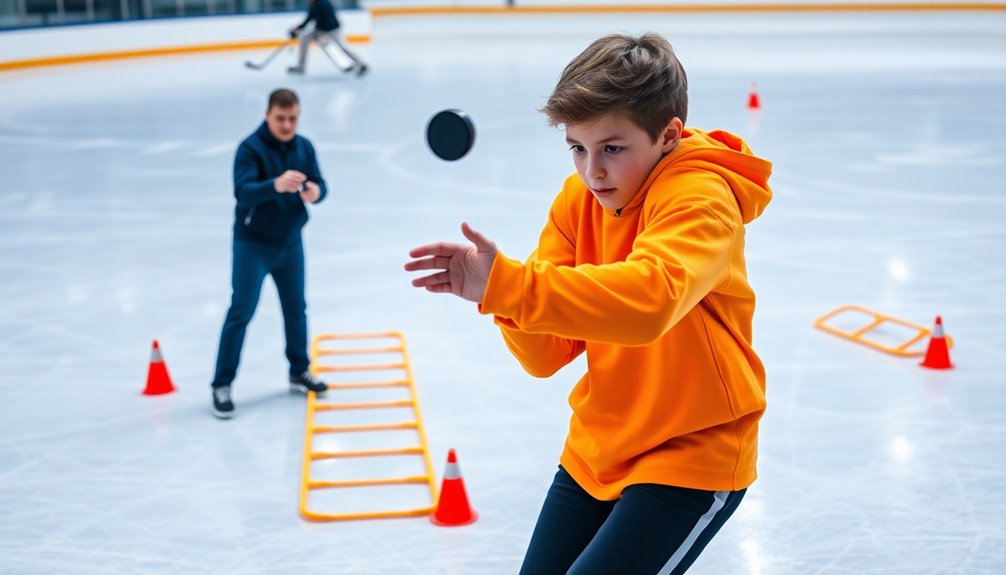
Factors Influencing Reaction Time
Numerous factors influence your reaction time on the ice, shaping how quickly you can respond to game situations. Genetics plays a noteworthy role in determining your baseline reaction speed; some players are naturally predisposed to quicker responses.
However, you can enhance your reaction time through training and experience. By learning to recognize patterns and anticipate gameplay, you'll find yourself reacting faster when it counts. Incorporating agility drills can significantly improve your response timing by simulating game scenarios. Regular practice of speed and agility drills also contributes to your overall quickness.
Your overall physical fitness, including agility and conditioning, also contributes to improved reaction capabilities. The better shape you're in, the quicker your movements will be on the ice.
Mental focus is equally important; staying aware and concentrated during gameplay can greatly reduce the time it takes for you to respond to stimuli.
Lastly, don't overlook environmental factors. Ice quality and lighting conditions can impact your performance, affecting both visibility and maneuverability. Being conscious of these elements can help you adapt and maintain peak reaction times amid varying conditions. Additionally, incorporating dynamic stretches into your warm-up can significantly enhance your flexibility and range of motion, ultimately aiding in quicker responses. By understanding these factors, you can work on improving your reaction time and gain an edge in your hockey performance.
Assessing Your Reaction Time
Evaluating your reaction time is essential for improving your hockey performance, as quick decisions can make all the difference on the ice. You can test your reaction speed using online tools or simple drills that focus on both mental and physical responses. Additionally, understanding basic rules of team dynamics can help you make quicker decisions during gameplay. Knowing the offside rule in soccer, for instance, can enhance your strategic thinking in team sports. Understanding the evolution of handball rules can also provide insights into how rules impact decision-making in competitive environments.
Importance of Reaction Time
Often overlooked, reaction time plays an essential role in hockey performance, where players must make split-second decisions. Your ability to respond quickly can be the difference between scoring a goal or missing an opportunity. Elite athletes achieve a reaction time of 0.2 seconds or less, while the average is around 0.3 seconds. This gap emphasizes the need for targeted training to improve your reaction time.
Several factors influence your reaction time, including:
- Genetics
- Training experience
- Physical fitness
- Focus
- Environmental conditions
Understanding these influences highlights the importance of a holistic training approach. Consistent practice and specialized drills can greatly improve your reaction time, making it a trainable skill despite its genetic components.
Utilizing tools like reaction time tests can help you track your progress and stay motivated.
As you work on enhancing your skills, remember that improvement takes time and dedication. By incorporating reaction time drills into your routine, you're not just aiming to keep up but to excel on the ice.
Testing Your Reaction Speed
To effectively gauge your reaction speed, you can utilize a variety of online tests designed to measure your visual response time. These tests are straightforward and can help you understand where you stand.
Generally, scores of 0.2 seconds or less indicate elite performance, while scores of 0.4 seconds or more suggest slower responses. The average reaction time for most individuals hovers around 0.3 seconds, giving you a benchmark to assess your performance.
Remember, reaction time is trainable, and consistent practice can lead to considerable improvements. Engaging in these reaction time tests not only provides you with motivation but also allows you to track your progress over time, making your training more effective.
You can compare your scores with peers, adding a competitive edge to your training tools.
Additionally, keep in mind that focus, concentration, and physical fitness notably impact your reaction time capabilities. Incorporating practical drills and exercises will give you a thorough understanding of your abilities and areas for improvement.
Factors Influencing Reaction Time
Several key factors influence your reaction time on the ice, and understanding them can help enhance your performance.
Here are the main elements that impact your ability to react quickly during games:
- Genetics: Your biological predisposition can determine how fast you respond to stimuli.
- Training and Experience: Regular practice and exposure to game scenarios sharpen your ability to recognize patterns, leading to quicker reactions.
- Physical Fitness: Agility and overall conditioning allow for faster movements, boosting your reaction capabilities.
- Focus and Concentration: Staying mentally alert can profoundly enhance your ability to react to unexpected situations.
- Environmental Factors: Conditions like ice quality and lighting can impact performance, requiring you to adapt your reactions accordingly.
Mental Overspeed Training Techniques
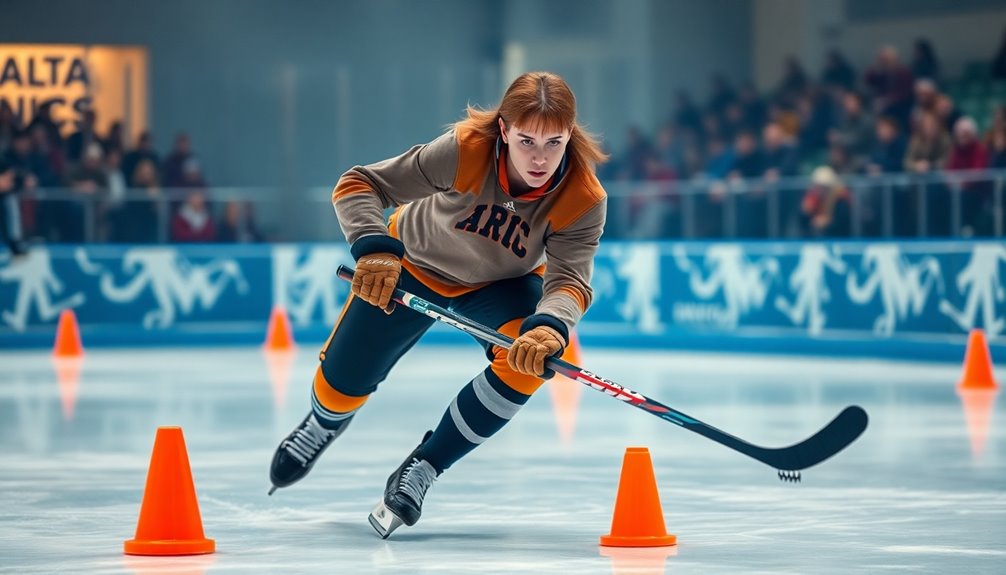
When you incorporate mental overspeed training techniques into your practice routine, you're setting the stage for significant improvement in your reaction time. This method involves exposing yourself to stimuli that are faster than typical game scenarios. By facing the hardest shots on your team or engaging with higher-level players, you'll experience quicker decision-making situations that can sharpen your skills. Additionally, practicing passing accuracy during these drills can improve your overall performance.
Research shows that training under increased speed conditions can enhance your brain's processing ability. As you regularly practice these fast-paced drills, you develop neural pathways that facilitate faster decision-making and responses during games. This means that when it's time to react in a live game, you'll be better equipped to anticipate and counter your opponents' movements effectively. Additionally, consistent effort in refining skills is crucial for achieving soccer success.
Mental overspeed training not only boosts your reaction time but also contributes to overall cognitive development. As you adapt to these challenging conditions, your brain learns to perceive the game at a slower pace, making it easier to handle high-pressure situations. Furthermore, incorporating speed and agility drills into your training routine can further enhance your performance on the ice.
Embrace this training approach, and you'll notice significant benefits in your performance on the ice.
Effects of Stimulants on Performance
When you consider using stimulants like caffeine to boost your performance, it's crucial to weigh the benefits against the risks.
While caffeine can enhance reaction time and decision-making under pressure, too much can lead to negative side effects like increased heart rate and anxiety.
Understanding how to use these substances wisely can help you maximize your game without compromising your health.
Caffeine's Impact on Performance
Caffeine greatly boosts athletic performance by enhancing reaction time, making it a favored choice among athletes. Research shows that caffeine can improve your reaction time by 10-20%, especially during intense activities.
When you're looking for that extra edge on the ice, caffeine may be just what you need. The ideal dosage for enhancing reaction time typically ranges from 3-6 mg per kilogram of body weight, so you'll want to find what works best for you.
Caffeine's effects kick in within 30-60 minutes after ingestion, aligning perfectly with your pre-game routine. However, be cautious; if you're not used to caffeine, it can lead to side effects like increased heart rate or anxiety.
Here are some tips for using caffeine effectively:
- Start with a lower dose to assess your tolerance.
- Experiment with timing to find your peak performance window.
- Stay hydrated, as caffeine can have a diuretic effect.
- Avoid consuming caffeine too late in the day to prevent sleep disruption.
- Monitor your body's response to adjust your intake accordingly.
Incorporating caffeine smartly can give you that boost in reaction time you're looking for on the rink!
Risks of Stimulant Use
While caffeine can provide a performance boost, it's vital to recognize the potential risks associated with stimulant use. Stimulants, like caffeine, can enhance your reaction time and mental alertness, but their effects vary markedly among individuals. This variance is influenced by genetic factors and tolerance levels, which means what works for someone else may not work for you.
Excessive use of stimulants can lead to negative side effects, including increased heart rate, anxiety, and sleep disturbances. These issues might ultimately hinder your athletic performance rather than improve it. Research shows that while moderate caffeine consumption can improve reaction times by 10-20%, overusing it can result in diminishing returns and even health risks.
Additionally, relying heavily on stimulants might lead to psychological dependence. This reliance can decrease your performance when you're not using them and increase your risk of substance misuse.
To avoid these adverse effects, it's important to conduct personal testing and consult with healthcare professionals before incorporating stimulants into your training regimen. Prioritizing your health and well-being is vital for sustained performance in hockey.
Benefits of Video Games
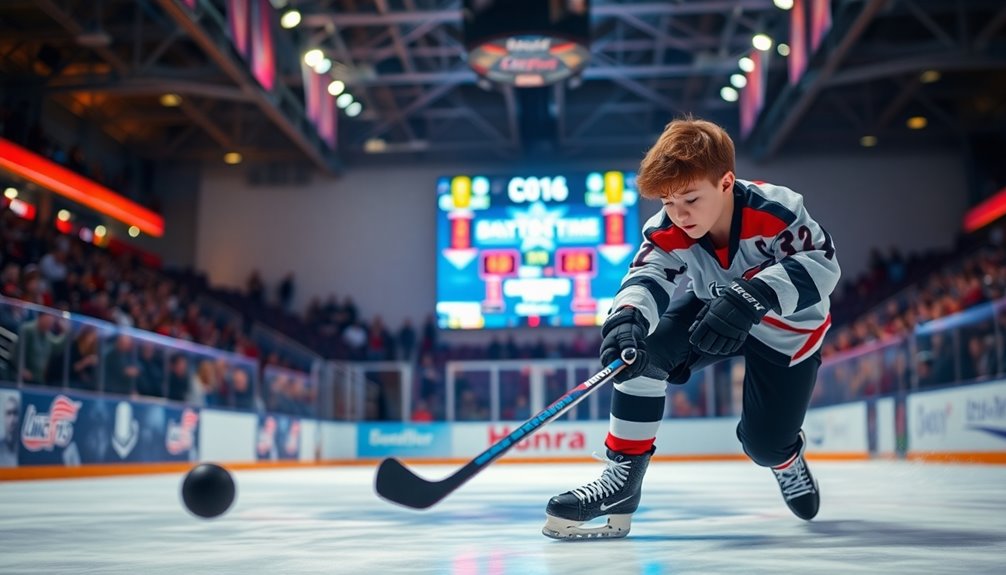
Video games offer several surprising benefits, particularly for athletes looking to enhance their performance. For hockey players, the skills gained from gaming can translate into improved on-ice abilities that boost your reaction time and overall gameplay.
Here are some key benefits of playing video games:
- Improved Reaction Speed: Action games can help you react 25% faster in tests compared to non-players.
- Enhanced Visual Processing: You'll quickly assess and respond to fast-paced situations, essential in hockey.
- Better Hand-Eye Coordination: Gaming improves your puck control and passing accuracy on the ice.
- Cognitive Flexibility: You'll adapt strategies and make quick decisions, which is critical during gameplay.
- Faster Information Processing: Regular gaming conditions your brain to respond promptly to on-ice stimuli.
Incorporating video games into your training routine can be a fun way to sharpen your skills.
By recognizing these benefits, you can leverage gaming to improve your performance as a hockey player.
Effective Warm-Up Strategies
Warming up effectively is essential for enhancing your performance on the ice. A good warm-up boosts your core temperature and increases your range of motion, which can improve your reaction time by up to 0.08 seconds compared to static stretches. Instead of static stretching, focus on dynamic stretching to prepare your body for the high-intensity demands of hockey.
Incorporate reaction time drills during your warm-up routine. These drills should utilize unpredictable auditory and visual stimuli to simulate real-game scenarios, helping sharpen your reflexes. By regularly including these drills, you not only enhance your immediate performance but also contribute to your long-term athletic development.
Additionally, an effective warm-up mentally prepares you for competition, giving you a psychological edge over your opponents. It sets the tone, allowing you to focus and get into the right mindset before hitting the ice.
Aim to engage in both physical movements and cognitive challenges during your warm-up. This combination will help you react faster during games, making you a more formidable player.
Ball Drop and Sprint Exercise
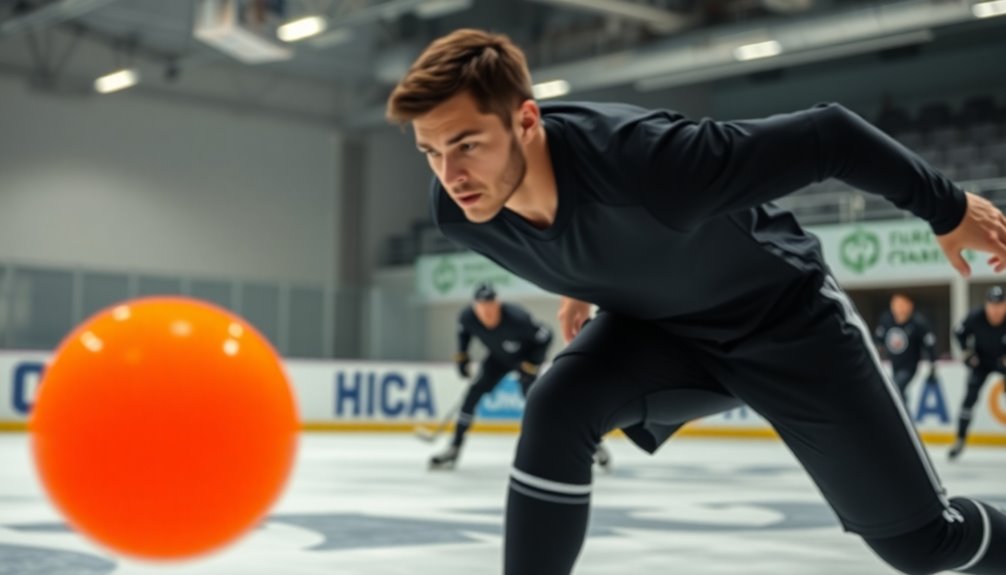
The Ball Drop and Sprint exercise is a fantastic way to sharpen your reaction time and boost your sprinting speed.
By working with a partner, you'll not only improve your agility but also enhance your hand-eye coordination as you rush to catch the ball.
This drill can elevate your overall performance on the ice, making you quicker and more responsive during gameplay.
Reaction Time Enhancement
Enhancing your reaction time is essential for excelling in hockey, and the Ball Drop and Sprint exercise is a fantastic way to achieve this. This drill involves a partner dropping a tennis ball from shoulder height, and your goal is to sprint and catch it before it bounces a second time. This quick response not only improves your reaction time but also helps you adapt to unpredictable game scenarios.
Incorporating the Ball Drop and Sprint into your training routine has several benefits:
- Improves reaction time: You'll learn to respond quickly to unforeseen events.
- Enhances spatial awareness: Understanding where you're in relation to the ball boosts your gameplay.
- Mimics game situations: The unpredictability of the drop simulates real-game pressure.
- Boosts overall performance: Regular practice leads to measurable improvements in quickness on the ice.
- Strengthens teamwork: Partner drills foster communication and synchronization.
Sprinting Speed Development
Building on your improved reaction time, developing sprinting speed is another vital element for success in hockey. The Ball Drop and Sprint exercise is an excellent way to achieve this. In this drill, your partner drops a tennis ball from shoulder height without warning, challenging you to sprint and catch it before it bounces twice. This not only enhances your reaction time but also greatly boosts your sprinting speed, which is essential during quick breakaways and defensive plays.
By regularly practicing the Ball Drop and Sprint, you'll encourage faster decision-making and a quicker physical response to stimuli, both fundamental skills for maintaining competitive performance on the ice.
This exercise can easily be integrated into your warm-up routines or performed as a standalone drill to maximize your agility and acceleration.
Consistent engagement in this exercise can lead to measurable improvements in both your reaction time and overall athletic performance. Whether you're a beginner or an experienced player, incorporating this drill into your training regimen will benefit your game.
Get ready to elevate your performance and outpace your opponents!
Partner Coordination Benefits
Improving your partner coordination through the Ball Drop and Sprint exercise can greatly elevate your on-ice performance. This drill not only hones your quick reaction skills but also enhances your overall agility and speed.
As one partner randomly drops a tennis ball, the other sprints to catch it before it bounces a second time, simulating the unpredictability of real game situations.
Here are some key benefits of this exercise:
- Enhances quick reaction: You learn to respond swiftly to unexpected stimuli.
- Improves sprinting speed: Frequent practice helps boost your acceleration and agility.
- Fosters teamwork: You communicate and coordinate with your partner to succeed.
- Requires no equipment: Easily incorporate this drill into your training routine anywhere.
- Simulates game scenarios: Prepare yourself for the fast-paced action of actual matches.
Partner Mirror Run Drill
The Partner Mirror Run Drill is a dynamic exercise that pairs two players to develop essential agility and reaction time skills. To perform the drill, start by standing one meter apart from your partner. One of you'll initiate movement in various directions—forward, backward, and sideways—while the other mirrors those movements. This fast-paced exercise should last for at least 30 seconds to effectively boost cardiovascular fitness and quick reflexive responses.
As you repeat the drill four times, focus on refining your movements and enhancing your adaptability to sudden direction changes, which is vital in hockey. The key to success lies in teamwork and communication; you both need to be aware of each other's movements to successfully mirror them.
Regular practice of the Partner Mirror Run Drill can lead to measurable improvements in overall agility and reaction time, greatly benefiting your performance in competitive hockey situations.
Shuffle Catches Technique
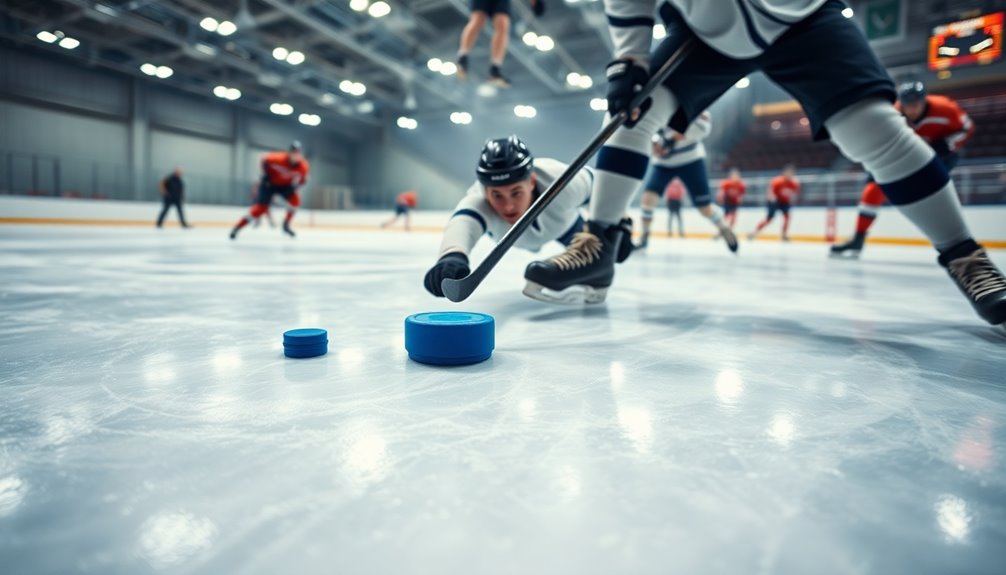
Shuffle Catches is a highly effective drill that sharpens your agility and hand-eye coordination, essential skills for any hockey player.
In this drill, you'll set up two cones five meters apart. While a partner throws a tennis ball, you'll shuffle between the cones, catching the ball as you move. This exercise enhances your reaction time and helps simulate real-game scenarios where quick reflexes are vital.
To get the most out of Shuffle Catches, follow these tips:
- Perform the drill for 30 seconds at a time to maintain intensity.
- Complete 4-5 sets to maximize your improvement.
- Focus on continuous movement to mimic game conditions.
- Communicate with your partner to improve teamwork skills.
- Track your progress to see measurable improvements in agility and reaction time.
Reaction Time Drill Variations
How can you keep your reaction time sharp and adaptable on the ice? Incorporating varied drills into your training routine can greatly enhance a player's ability to respond quickly in game situations.
One effective drill is the Ball Drop and Sprint Drill. Here, your partner drops a tennis ball randomly, and you sprint to catch it before it bounces again, boosting your speed and reflexes.
Another option is the Partner Mirror Run, where you stand a meter apart, mirroring each other's movements for 30 seconds. This exercise sharpens agility alongside reaction time, and you can repeat it four times for maximum benefit.
Try Shuffle Catches as well, where you shuffle between two cones while catching a tennis ball thrown by a partner. This not only hones your hand-eye coordination but also keeps your reaction speed sharp.
For a more cognitive challenge, the Dynamic Zone Shift Drill simulates game-like scenarios where you practice shifting between offense and defense based on changing stimuli.
Each of these drills plays an essential role in enhancing a player's overall reaction time, preparing you for the fast-paced demands of hockey.
Comprehensive Training Programs
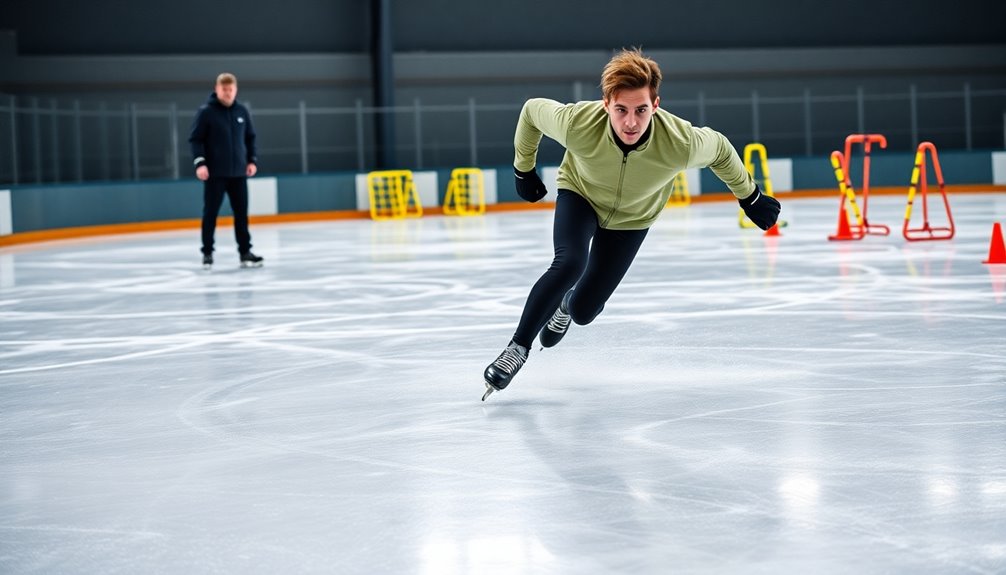
To truly elevate your game, extensive training programs offer a structured approach that blends specialized drills with cognitive skill development. These programs are designed for hockey players who want to sharpen their reaction time and overall performance on the ice.
For instance, the 30-Day Breakaway Speed System focuses on progressive training routines that challenge you to improve both speed and reaction time.
Incorporating specific tools can enhance your training experience:
- Hockey Reaction Ball: Improves hand-eye coordination and quick reflexes.
- Edge Work Enhancer Ladder: Boosts agility and explosive skating speed.
- Regular Reaction Time Drills: Measurable improvements in competitive scenarios.
- Simulation Technology: Develops quick decision-making skills through realistic game situations.
- Tailored Drills: Target both physical and cognitive skills for holistic development.
Enhancing Skills With Hockey Intelligym
One effective way to enhance your hockey skills is by incorporating Hockey IntelliGym into your training routine. This innovative program utilizes advanced simulation technology, creating realistic game scenarios that allow you to practice and improve your cognitive skills in a virtual environment.
By engaging with Hockey IntelliGym, you'll focus on developing neural pathways through repeated exposure to game-like situations, which can greatly boost your reaction time and decision-making abilities.
The tailored training programs within IntelliGym cater to different skill levels and positions, ensuring you receive targeted cognitive development. Research shows that players who use cognitive training tools like IntelliGym see improved anticipation skills and quicker responses during actual gameplay.
This is vital during a hockey match, where split-second decisions can make all the difference.
Incorporating IntelliGym into your regular practice can lead to a competitive advantage, as you'll become better at reading the game and reacting swiftly to dynamic situations on the ice.
By improving your reaction time and cognitive skills, you'll not only enhance your performance but also elevate your overall game strategy.
Make Hockey IntelliGym a part of your training and watch your skills soar!
Continuous Improvement Strategies
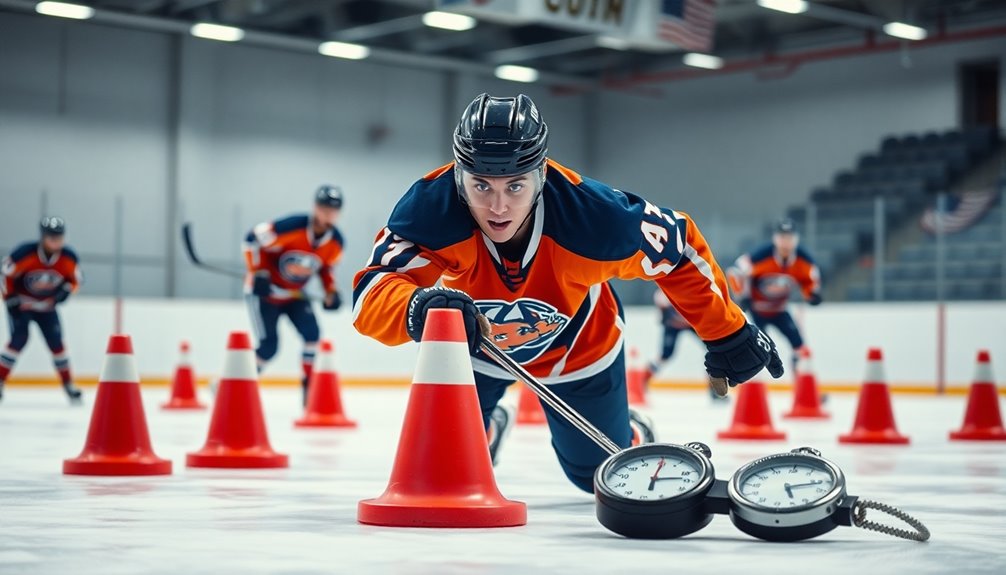
Continuous improvement in hockey requires a strategic approach to your training regimen.
To enhance your reaction time on the ice, you need to adopt a combination of physical drills and cognitive training. Here are some effective strategies to evaluate:
- Regularly practice reaction time drills like Ball Drop and Sprint or Shuffle Catches.
- Incorporate cognitive training tools, such as Hockey IntelliGym, to simulate game scenarios.
- Establish a consistent practice schedule that focuses on both physical exercises and mental challenges.
- Engage in diverse training methods, including agility drills and mental overspeed training, to improve adaptability.
- Monitor your progress with reaction time tests to set benchmarks and adjust your training programs accordingly.
Conclusion
So, if you think you can just waltz onto the ice without training your reaction time, think again! You might as well be trying to catch a puck with a butterfly net. By incorporating these exercises and techniques into your routine, you'll not only boost your performance but also impress your teammates. After all, who doesn't want to be the player that reacts faster than a cat chasing a laser pointer? Get out there and start training!

